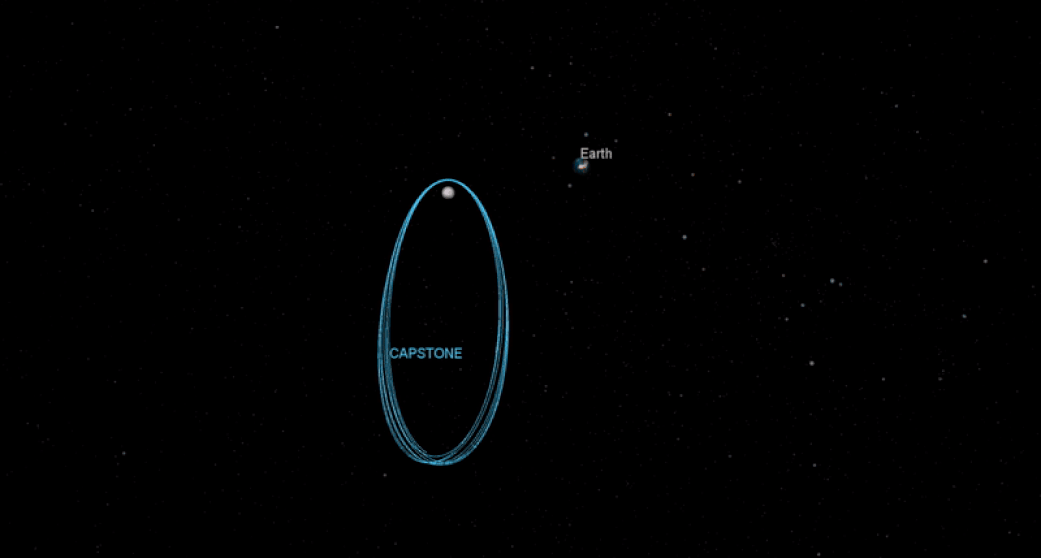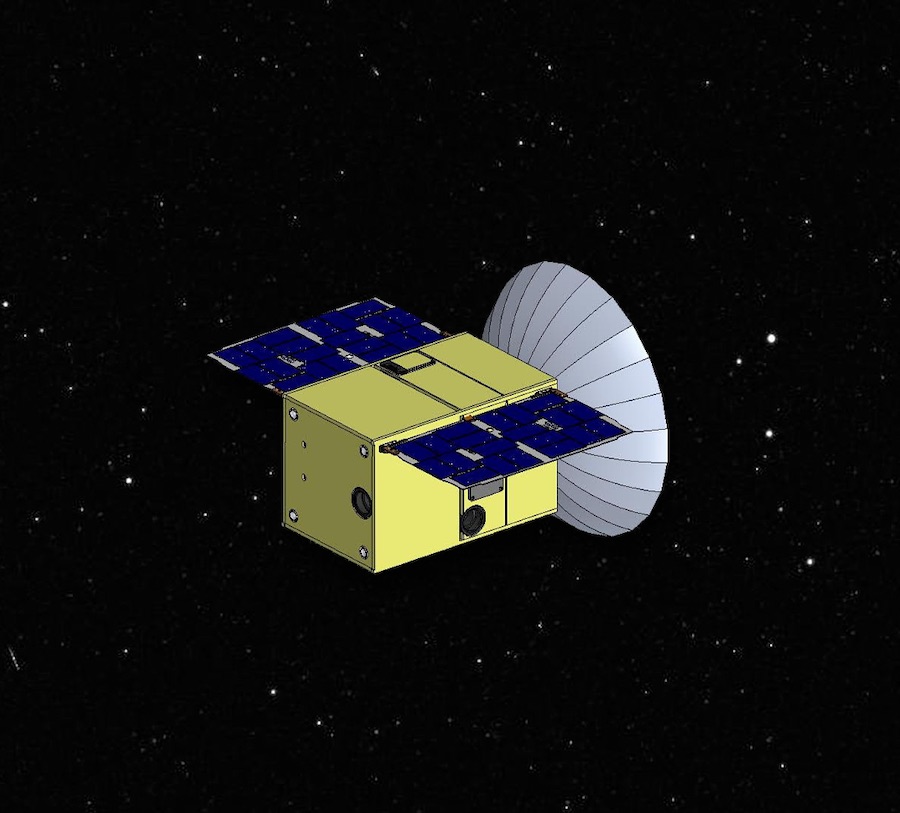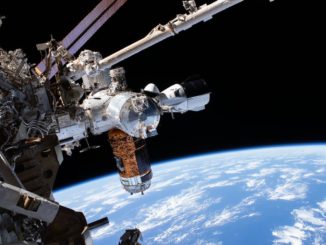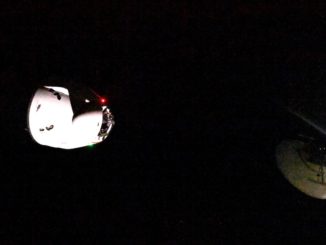
As soon as next year, NASA plans to launch a CubeSat the size of a microwave oven into a unique elliptical orbit around the moon as a scout for the future lunar Gateway, a mini-space station NASA intends to use as a staging point for crewed lunar landings beginning as soon as 2024.
The commercially-built CubeSat, named CAPSTONE, will conduct deep space navigation experiments and demonstrate maneuvers to enter and operate in a near rectilinear halo orbit, an elliptical orbit around the moon that will be home to the Gateway, a critical piece of NASA’s architecture to return humans to the lunar surface.
The Trump administration has directed NASA to attempt a crewed lunar landing by the end of 2024. Earlier this year, NASA named the moon program Artemis, the twin sister of Apollo in Greek mythology.
Along with the Orion crew ferry capsule, the Space Launch System heavy-lift rocket, and a new human-rated lunar lander, the Gateway is a core component of NASA’s Artemis program.
The first section of the Gateway, known as the Power and Propulsion Element, is scheduled for launch around the end of 2022. The PPE will be built by Maxar Technologies in partnership with several companies, including Blue Origin, which could provide a launch vehicle for the first Gateway element.
A module to provide basic living quarters for astronauts will launch by the end of 2023. NASA has selected Northrop Grumman for a sole-source contract too built the Gateway habitation outpost, which will be derived from the company’s Cygnus supply ship that carries cargo to the International Space Station.
In the meantime, according to NASA’s current plans, the SLS will launch on its first test flight — likely no earlier than 2021 — with an unpiloted Orion spacecraft into a roughly circular so-called distant retrograde orbit around the moon. A four-person crew could launch in 2022 or 2023 on the next SLS/Orion mission and fly on a single loop around the moon — without entering lunar orbit — before coming back to Earth on a free return trajectory.
Before the launch of the first element of the Gateway, NASA’s CAPSTONE mission will scout the near rectilinear halo orbit, or NRHO, for the first time.
“Gateway is not dependent on this mission, but CAPSTONE will likely be the first spacecraft in the near rectilinear halo orbit, and this is a dynamic environment … (with) the influence of multiple gravitational bodies,” said Christopher Baker, NASA’s small spacecraft technology program executive. “So CAPSTONE will help us reduce the logistical uncertainty by verifying what our models are telling us, including the dynamics for entering the NRHO, staying within that orbit, low-energy resupply trajectories for Gateway … and then it’s also a technical demonstration for a peer-to-peer navigation solution for cislunar space.”
CAPSTONE stands for the Cislunar Autonomous Positioning System Technology Operations and Navigation Experiment.
The near rectilinear halo orbit will take the CAPSTONE spacecraft, and eventually the Gateway, as close as 1,000 miles (1,500 kilometers) and as far as 43,500 miles (70,000 kilometers) from the moon.
The orbit selected for the Gateway “is an orbit of the moon, but it’s more of an orbit between the Earth and the moon,” said Marshall Smith, director of NASA’s human lunar exploration programs.
The near rectilinear halo orbit comes with several advantages, Smith said Thursday in a presentation to the National Academies’ Aeronautics and Space Engineering Board.
A station in such an orbit will have a continuous communications link with Earth, and it allows landers departing from the Gateway to reach any place on the lunar surface with only modest propellant usage, Smith said.

A station like the Gateway is needed because the Orion spacecraft, which will carry crews to and from the vicinity of the moon, does not have the ability to maneuver directly into and out of a low-altitude lunar orbit, like the Apollo spacecraft did in the 1960s and 1970s.
“We’ve been looking at orbits for quite a while,” Smith said Thursday.
The Orion spacecraft was originally conceived in the mid-2000s for NASA’s Constellation moon program under the George W. Bush administration. The behind-schedule Constellation program was canceled in 2010, and the Obama administration wanted to bypass a lunar landing program and focus on a human expedition to Mars.
The Constellation-era Orion spacecraft would have had a U.S.-built service module, which contains the ship’s rocket engines and power-generating solar arrays.
The U.S.-made service module would have had the capability to change the Orion spacecraft’s velocity in space by up to 4,000 mph, or 1,800 meters per second, during a single mission, Smith said.
“Great, we could go to low lunar orbit and do everything we wanted to do,” Smith said. “But we decided at some point we weren’t going to the moon after Constellation … and we wanted to have an international partnership.”
The total velocity change, or delta-V, provided by the Orion spacecraft’s European-built service module on a single mission is roughly 2,700 mph (1,200 meters per second).
“That’s not enough to go to low lunar orbit (and come back to Earth),” Smith said. “But we weren’t going to the moon. we’re going to the vicinity of the moon because we’re going to Mars … So we made the change to go do that.
“We have the capability to put Orion in low lunar orbit,” Smith said Thursday. “We don’t have the capability to get it out because it doesn’t have enough delta-V, which is a problem. The SLS can put it there … That’s not the issue. A lot of people blame the SLS for that. It’s not SLS. It’s the ESA service module that doesn’t have the delta-V.
“So, with that, we’re limited on our capability with Orion, so we have to look at higher orbits, and what we want to do is get a near pass to the moon,” Smith said.
The near rectilinear halo orbit provides just that. A more circular orbit farther from the moon, such as the distant retrograde orbit previously favored for Mars-oriented staging base, would require a lunar lander to carry more propulsive capability to fly to the moon’s surface and back into space.
“What we want do is make sure the descent element and the ascent element (of the lander) have as low of a delta-V as possible,” Smith said. “So we want to have a close approach (to the moon on each orbit). This NRHO allows us to have a close approach.”
Smith said Thursday the release of a final solicitation from NASA is “imminent” for U.S. companies to propose designs for a human-rated lander. Before the end of the year, NASA aims to select up to four companies to refine their lunar lander designs.
That assumes NASA receives an extra $1 billion from Congress in its fiscal year 2020 budget, funding requested by the Trump administration earlier this year to kick-start lunar lander development efforts. The rest of the White House’s proposed $1.6 billion budget augmentation for the Artemis program included money to maintain the development schedule for the SLS and Orion programs to meet the Trump administration’s 2024 deadline.
NASA’s moon program was on a pace for a human lunar landing in 2028 before Vice President Mike Pence charged the agency in March to move that timeline up by four years.
The fiscal 2020 budget bill passed by the House of Representatives in June did not include the $1.6 billion in extra funding for the Artemis program. An appropriations bill marked up by the Senate Appropriations Committee this week proposed $744 million for development of human-rated lunar landers, $256 million short of what NASA said it needed.

Credit: Tyvak Nano-Satellite Systems
While funding for a 2024 lunar landing remains uncertain, NASA is moving ahead with the Gateway.
NASA announced Sept. 13 it awarded a $13.7 million contract to Advanced Space, a small company based in Boulder, Colorado, to develop and operate the CAPSTONE CubeSat.
“CAPSTONE will be the first satellite mission that Advanced Space has led,” wrote Bradley Cheetham, president and CEO of Advanced Space, in an email. “As a company, we have supported mission planning and operations for partners and customers, but this will be our first mission as the prime. It is an exciting opportunity for us demonstrate and improve mission enabling technologies in a rapid and affordable way.”
In a statement, NASA described CAPSTONE as a “rapid lunar flight demonstration” that could launch as soon as December 2020.
“This mission is highly ambitious in both cost and schedule – and taking that deliberate risk is part of the objective of this mission – alongside the rapid technological advancement in cislunar navigation and the opportunity to verify orbital trajectory assumptions and retire unknowns for future missions,” said Jim Reuter, associate administrator for NASA’s space technology mission directorate.
CAPSTONE will carry a communications system to determine its range from NASA’s Lunar Reconnaissance Orbiter, and how fast the distance is changing. The experiment will demonstrate software for autonomous navigation in deep space — well above the GPS satellites — allowing future spacecraft to determine their location without relying on tracking from Earth.
“We ultimately we need to enable navigation with reduced dependency on Earth,” Baker said in an interview with Spaceflight Now. “So if one mission, in this case LRO, is able to determine its location based on communication with Earth assets, and another mission like CAPSTONE is able to determine its relative position off of that spacecraft, then CAPSTONE and any other spacecraft like it can figure out where it is in space without having to rely on direct support from Earth for that navigational aid.”
CAPSTONE will carry a small camera, but no other payloads.
“Beyond the hardware for the navigation experiment, there is a camera, but in the interests of moving quickly and keeping with the CubeSat ethos, we’re really trying to keep the spacecraft as focused on that primary mission as possible,” Baker said.
The CAPSTONE spacecraft is funded through NASA’s space technology directorate. The agency’s human spaceflight division will pay for CAPSTONE’s launch on a commercial rocket, either as a secondary payload on a large booster or aboard a dedicated small launcher, Baker said.
“Rideshare or a dedicated small launch vehicle are all within the realm (of possibility),” Baker said. “We’re just looking to do it quickly, at low cost, and using a commercial vehicle.”
Around three months after launch, CAPSTONE will use its own propulsion system — fed by a green propellant or hydrazine fuel — to steer into the Gateway’s planned near rectilinear halo orbit.
“That’s actually part of the experiment, using that propulsion system to get into that near rectilinear halo orbit, and then station-keep within that near rectilinear halo orbit,” Baker said. “Right now, we are trying to use a green propellant. Hydrazine is a backup.”
CAPSTONE’s primary mission is set to last around six months after it arrives in orbit around the moon, according to NASA.
Advanced Space is developing the CAPSTONE mission’s lunar navigation experiment, and will manage the mission for NASA. Tyvak Nano-Satellite Systems, a smallsat builder in California, will manufacture CAPSTONE’s spacecraft platform.
Email the author.
Follow Stephen Clark on Twitter: @StephenClark1.



